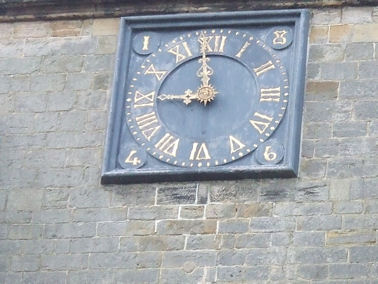
Hurstpierpoint looking North East

|
Hurstpierpoint looking North East |
|
Home Page |
Bells & History |
Practices |
Handbells |
News, events & photos |
Newsletters |
Learning |
Archives |
Contact Us |
Links |
The Bells and their history
The VillageThe village name derives from 'Hurst', the Saxon name for a wood, and 'Pierpoint' from the de Pierpoint family who arrived with William the Conqueror in 1066. The settlement was mentioned in the Domesday Book. Throughout the centuries there have been several variants on the name e.g. Herst (11th century); Herstperpunt (14th century) and Perpondesherst (15th century). The original part of the village is chiefly a long street running east-west. Most of the buildings there are 18th century or later but there are more recent additions to the north (on the road to Cuckfield) and to the west. The Bells and their inscriptions
| |||||||||||||||||||||||||||||||||||||||||||||||||||||||
|
The Doves Guide entry to Holy Trinity, Hurstpierpoint can be found here | |||||||||||||||||||||||||||||||||||||||||||||||||||||||
|
| |||||||||||||||||||||||||||||||||||||||||||||||||||||||
|
| |||||||||||||||||||||||||||||||||||||||||||||||||||||||
The clock | ||

Click image to magnify it |
The clock, perhaps unusual in that it has no south-facing dial, was constructed in 1846 by B.L. Vulliamy, a famous London clockmaker, though ours was described by the patron of the living at the time as "by a famous man but not a very good clock". It has a dead beat escapement in a cast iron ‘plate and spacer frame’. The pendulum has a two second period. Initially there were no quarter chimes. These were added in 1874, in a separate frame, when the mechanism was overhauled by Edward Funnell of Brighton. It now consists of 3 trains: going, striking and quarters. The manual winding mechanism was converted to an automatic electric system in 1980. In 1987 the clock hammers, cranks and wires were overhauled and in 2023 the escapement was overhauled by the Cumbria Clock Co. Timekeeping is fairly good, but intervention with weights placed on, or removed from, a plate below the pendulum is needed from time to time. For more details of the clock and its history, see below. |
Click image to magnify it |
History | ||
|
The history of the bells has been traced and documented by one of the ringers, John Norris. He has put together a small publication on the subject and this can be downloaded as an Adobe PDF file called The Church Bells of Hurstpierpoint. Its download size is 7.4Mb. You will need the free Adobe Reader or similar to view it; if you don't have either you can download Adobe Reader free here.
| ||